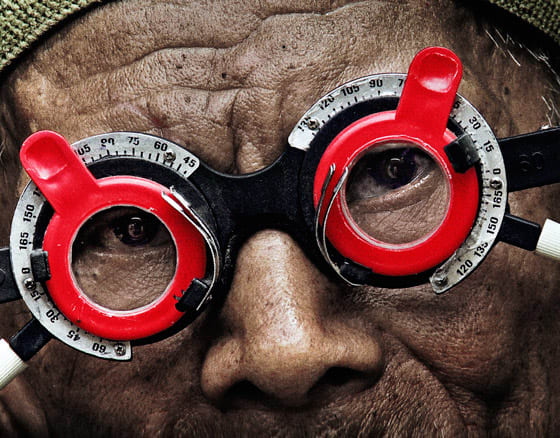Much like his companion piece, the Oscar-nominated Act of Killing, Joshua Oppenheimer's The Look of Silence presents a single perspective on the mid-'60s Indonesian genocide through repetitive gimmick. Where its predecessor had the perpetrators of those killings re-enact their bloody memories through abstract performance art and visceral description, Silence shifts its gaze to that of the victims; or rather, that of the brother of a victim confronting those involved in the mass slaughter. Presumably, this framework modification aims to contextualize, or justify, the sensationalist nature of the original doc, giving those affected a visible vested interest in a subject that was previously just a creatively staged shock to the senses.
As a narrative, this issue doc follows a deliberately unnamed optometrist into the homes of a killer, some political leaders and even a guard as he confronts their memories while testing their eyesight. (Get it? He's trying to help them see clearly metaphorically and literally.) At home, he watches the video re-enactment of his older brother's brutal slaughter when not having entirely staged, exceedingly unnatural conversations with his wife about the danger he's putting himself in or with his daughter about the historical inaccuracies of what she's being taught in school.
The gauche inauthenticity of these ostensibly humanizing moments is just one of the problems with Oppenheimer's doc. The need to heighten the threat of the situation and exploit the naivety of a child for gentle emotional manipulation is a tad desperate. Similarly, other staged moments, such as the filming of our protagonist's reaction to the description of his brother's death, brings into question the intentions of the subject as well as those of the documentarian. It's a grisly, harrowing and entirely inhumane moment of recollection being milked for all its worth.
The other concern about this particular approach is that of logical benefit. The optometrist indicates that his motivation for confronting these men is to find a kernel of regret. Yet, when he confronts them, his questions and approach are passive-aggressive and antagonistic; he easily pokes holes in their logic, explaining the propaganda element of justifying killing by indulging in a broad dismissal of communist morality, ultimately seeming to take some pleasure in making them feel stupid. This inevitably results in threats and defensiveness, which is entirely unsurprising. If he were truly interested in determining if there was a shred of humanity in these people, as is stated in yet another overtly staged moment, the approach wouldn't consistently be that of poking the bear.
Now, none of these criticisms are to say that there isn't necessity and purpose behind these experiments in confronting memory and history; it's important that the political and social indicators of events like this are understood in both a preservationist and preventative capacity. But in repeatedly indulging in the most depraved aspects of the event and pushing the buttons of older men that have long been brainwashed in their ways, Oppenheimer is taking more of a pitchfork-and-torches approach to the issue. At the end of The Look of Silence, the real question is: What was gained from making this movie?
(Blue Ice Docs)As a narrative, this issue doc follows a deliberately unnamed optometrist into the homes of a killer, some political leaders and even a guard as he confronts their memories while testing their eyesight. (Get it? He's trying to help them see clearly metaphorically and literally.) At home, he watches the video re-enactment of his older brother's brutal slaughter when not having entirely staged, exceedingly unnatural conversations with his wife about the danger he's putting himself in or with his daughter about the historical inaccuracies of what she's being taught in school.
The gauche inauthenticity of these ostensibly humanizing moments is just one of the problems with Oppenheimer's doc. The need to heighten the threat of the situation and exploit the naivety of a child for gentle emotional manipulation is a tad desperate. Similarly, other staged moments, such as the filming of our protagonist's reaction to the description of his brother's death, brings into question the intentions of the subject as well as those of the documentarian. It's a grisly, harrowing and entirely inhumane moment of recollection being milked for all its worth.
The other concern about this particular approach is that of logical benefit. The optometrist indicates that his motivation for confronting these men is to find a kernel of regret. Yet, when he confronts them, his questions and approach are passive-aggressive and antagonistic; he easily pokes holes in their logic, explaining the propaganda element of justifying killing by indulging in a broad dismissal of communist morality, ultimately seeming to take some pleasure in making them feel stupid. This inevitably results in threats and defensiveness, which is entirely unsurprising. If he were truly interested in determining if there was a shred of humanity in these people, as is stated in yet another overtly staged moment, the approach wouldn't consistently be that of poking the bear.
Now, none of these criticisms are to say that there isn't necessity and purpose behind these experiments in confronting memory and history; it's important that the political and social indicators of events like this are understood in both a preservationist and preventative capacity. But in repeatedly indulging in the most depraved aspects of the event and pushing the buttons of older men that have long been brainwashed in their ways, Oppenheimer is taking more of a pitchfork-and-torches approach to the issue. At the end of The Look of Silence, the real question is: What was gained from making this movie?




